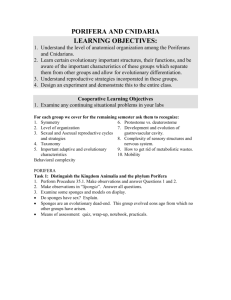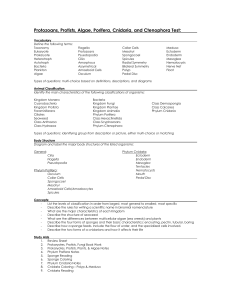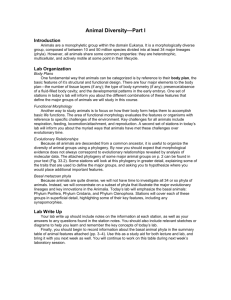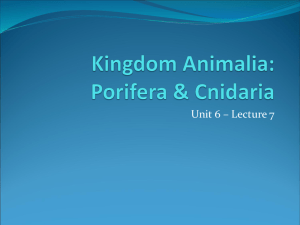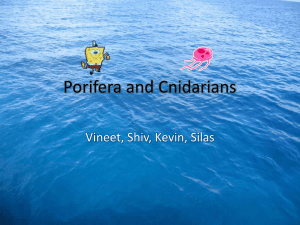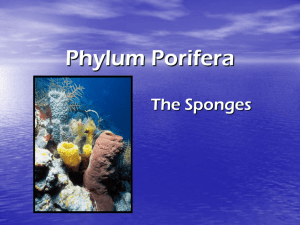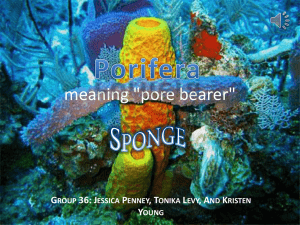Other Systematics(Animals, Archeae, Bacteria, etc.)
advertisement
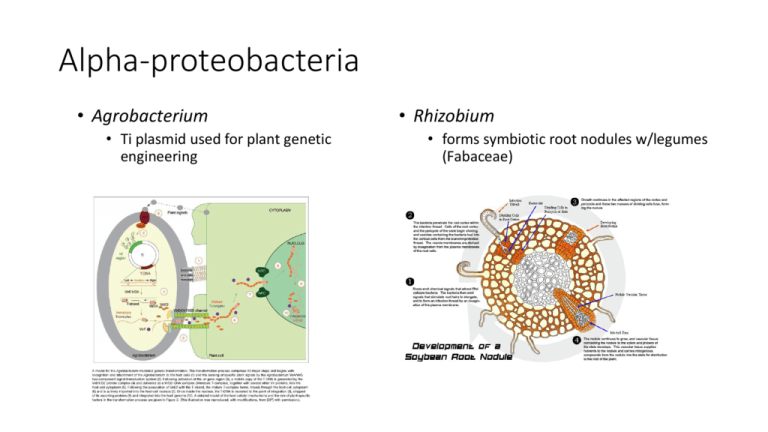
Alpha-proteobacteria • Agrobacterium • Ti plasmid used for plant genetic engineering • Rhizobium • forms symbiotic root nodules w/legumes (Fabaceae) Gamma-proteobacteria • Escherichia • E. coli model organism • catalase-positive • Salmonella • catalase-positive • typhoid, food poisoning • most subspecies produce hydrogen sulfide as a metabolic byproduct Gram-positives • Bacillus • • • • endospore-forming catalase-positive anthrax B. subtilis model organism • Streptomyces • originated many antibiotics (streptomycin, tetracycline, chloramphenicol) • high-GC genomes Others • Anabaena • cyanobacterium • heterocysts engage in nitrogen fixation • symbiotic relationship with Azolla fern (functionally similar to Rhizobium+legumes) • Thermus • T. aquaticus DNA polymerase used in PCR Archaea • Similar to Eukarya: • histone-associated DNA • translation initiated with methionine • Similar to Bacteria: • • • • external morphology circular genome operons, polycistronic mRNA no introns/RNA processing Examples • Methanobacterium • type of methanogens (methanogens are not monophyletic) • obligately anaerobic • reduce CO2 to CH4 using H2 • Thermoplasma • high-temperature acidophiles • facultative anaerobes (can respire using sulfur in anaerobic conditions) • no cell walls • Halobacterium • aerobic • high-salt environments (protein function) • uses bacteriorhodopsin as proton pump for ATP generation • Sulfolobus • high-temperature acidophiles • can grow lithoautotrophically by oxidizing sulfur to sulfates • chemoheterotrophs by using sulfur to oxidize carbon compounds Euglenozoa – Euglenids • possess chloroplasts through secondary endosymbiosis of green algae (thus their chloroplasts have three membranes) • no cell wall, but pellicle made of protein • pyrenoids store paramylon (carbohydrate similar to starch) • Euglena Euglenozoa – Kinetoplastids • all possess a kinetoplast: dense DNA granule within mitochondrion, located at the cell’s basal body • Trypanosoma • obligate, heteroxenous parasites • T. cruzi – Chagas’ disease • T. brucei – African sleeping sickness Stramenopiles – Phaeophyta • brown algae • all multicellular • possess xanthophyll called fucoxanthin, giving distinctive color • body called a thallus • holdfast “root” • stipe “stem” • pneumatocysts provide buoyancy • Sargassum • oogamous, diploid body Stramenopiles – Bacillariophyta • diatoms • enclosed in silicon-based cell wall called a frustule • sexual reproduction involves formation of an auxospore • four-membraned chloroplasts (characteristic of all stramenopiles) • Diatoma Alveolates – Apicomplexa • intracellular animal parasites w/ complex life cycles • apicoplast: four-membraned plastid involved in host cell penetration • generally sporozoites infect a host, replicating in cells to produce merozoites which infect other cells • Plasmodium Alveolates – Ciliates • possess a diploid micronucleus (for reproduction) and polyploid macronucleus (for transcription) • asexual reproduction occurs via binary fission • conjugation: micronuclei undergo meiosis and haploid micronuclei are exchanged over the mating bridge • organelles called trichocysts that release hairs in response to stimuli Alveolates - Dinoflagellates • characterized by 2 flagella, one transverse and one longitudinal • lack histones, nucleosomes • haploid • most possess a dinokaryon nucleus • DNA condensed throughout interphase • nuclear membrane does not break down • mitotic spindle is extranuclear • Ceratium Rhodophyta • red algae • color due to phycoerythrin pigment • carbohydrate stored as floridean starch, more highly branched than amylopectin • many exhibit complex alternation of generations with 2 sporophyte generations • Chondrus Amoebozoa - Lobosea • Unikonts (previous protists were dikonts) • Amoeba • endoplasm/ectoplasm: differential flow of cytoplasm causes movement • actin-based pseudopodia appendages Amoebozoa – Eumycetozoa • Slime molds • Myxogastria: • plasmodial slime molds • single-celled, haploid myxamoebas/myxoflagellates • extended diploid multinucleate reproductive form called plasmodium • Dictyostelia: • cellular slime molds • single-celled and mononucleate haploids • aggregate into multiorganismic “pseudoplasmodium” (still haploid) • sexual reproduction involves macrocyst formation • Dictyostelium Zygomycota • characterized by zygosporangium, a resistant diploid reproductive structure • cell walls made of chitosan, deacetylated chitin • Mucor Ascomycota • sexual reproduction involves formation of asci in an ascocarp • • • • each ascus has eight ascospores tissue layer containing asci: hymenium apothecium: hymenium open outward cleistothecium: hymenium closed, bursts open • perithecium: hymenium closed off except for a single pore • most lichens have ascomycete mycobionts • Penicillum • Saccharomyces • no ascocarps, naked asci • Claviceps causes ergot infections Basidiomycota • Long heterokaryotic stage • Clamp connections to coordinate division of dikaryotic nuclei • Form basidia containing basidiospores, which germinate into haploid mycelia • Agaricus • Rusts: • obligate parasites, many requiring more than one host • complex life cycle w/ up to 5 different spore types • Puccinia Animals • Porifera • eukaryotic, multicellular • heterotrophic • no cell walls Porifera • water flows through ostia out to osculum • flagellated choanocytes collect food • asconoid, synocoid, leuconoid structures • Spongia Animals • Porifera • Cnidaria • Anthozoa • Scyphozoa • Hydrozoa • Ctenophora • true tissues • germ layers Cnidaria Polyp? Medusa? Species Anthozoa Yes No Anemonia, Corallium Scyphozoa Yes Yes Aurelia Hydrozoa Yes Yes Hydra Ctenophora • Two-cell layer surrounding mesoglea (one-cell thick in Cnidaria) • swim using combs of cilia • no cnidocytes; instead colloblasts release adhesive substance • Mertensia Animals • Porifera • Cnidaria • Ctenophora • Bilateria • Protostomia • Platyhelminthes • Lophotrochozoa • Ecdysozoa • triploblastic body • bilateral symmetry • schizocoelous development • spiral, determinate cleavage Platyhelminthes • Turbellaria: • paraphyletic, all free-living flatworms • Pseudoceros • Cestoda: • strictly sexual reproduction • Echinococcus • Trematoda: • heteroxenous parasites (mollusk + vertebrate) • Schistosoma Animals • Porifera • Cnidaria • Ctenophora • Bilateria • Protostomia • Platyhelminthes • Lophotrochozoa • Mollusca • Annelida • Ecdysozoa • Trochophores: produce trochophore larvae (with two bands of cilia around middle) • Lophophore: band of tentacles around mouth • closed digestive systems • coeloms Lophotrochozoa – Mollusca • Gastropoda: • Arion (slugs) • Achatina (snails) • Cephalopoda: • Nautilus • Sepia (cuttlefish) • Bivalvia: • Pinctada (pearl oysters) Lophotrochozoa – Annelida • Polychaeta: • parapodia serve as gas exchange • protostomium equipped with palps, nuchal organs, eyes, antennae • Nereis • Oligochaeta: • • • • no parapodia prostomium not well-developed Lumbricus Hirudo (leech) Animals • Porifera • Cnidaria • Ctenophora • Bilateria • Protostomia • Platyhelminthes • Lophotrochozoa • Mollusca • Annelida • Ecdysozoa • Nematoda • Arthropoda • periodically shedding cuticle Ecdysozoa – Nematoda • pseudocoelomates • Caenorhabditis Animals • Porifera • Cnidaria • Ctenophora • Bilateria • Protostomia • Deuterostomia • Echinodermata • Asteroidea • Holothuroidea • Echinonoidea • Chordata • triploblastic body • bilateral symmetry • enterocoelous development • radial, indeterminate cleavage Echinodermata • Asteroidea: • Linckia • Echinoidea: • Diaderna • Holothuroidea: • Holothuria Animals • Porifera • Cnidaria • Ctenophora • Bilateria • Protostomia • Deuterostomia • Echinodermata • Chordata • Urochordata • Cephalochordata • Vertebrata • notochord • dorsal nerve cord • pharyngeal slits • post-anal tail Urochordata (Tunicata) • some are sessile; others are freefloating • filter feeders, with incurrent + excurrent siphon • Ascidia Cephalochordata • lancelets • notochord persisting throughout life • filter-feeders, usually half buried in sediment • Branchiostoma Animals • Porifera • Cnidaria • Ctenophora • Bilateria • Deuterostomia • Chordata • Vertebrata • Hyperoartia • Gnathostomata • cephalization • vertebral column • doubling of Hox clusters (lancelets, tunicates have only one set) • neural crest Hyperoartia • parasitic or filter-feeders • Petromyzon Animals • Deuterostomia • Chordata • Vertebrata • Gnathostomata • Chondrichthyes • Osteichthyes • jaws (developed from first gill arch) • another doubling of Hox clusters (now there are four) • lateral lines Chondrichthyes • contain Leydig’s organ, involved in erythropoiesis • skin is covered in denticles • Carcharodon (great white) • Dasyatis (stingrays) • Apristurus (catshark) Animals • Deuterostomia • Chordata • Vertebrata • Gnathostomata • Osteichthyes • Actinopterygii • Sarcopterygii • lungs (swim bladders) • one dorsal fin Actinopterygii • fin rays (fins supported by bony spines) • Carabus (sturgeons) • Barbus (barbell) • Anguilla (freshwater eels) • Salmo (salmon) Animals • Vertebrata • Gnathostomata • Osteichthyes • Sarcopterygii • Dipnoi • Coelocanthomorpha • Tetrapoda • bony fins surrounded by muscle • two dorsal fins • teeth with true enamel Coelocanthomorpha, Dipnoi • Coelocanthomorpha: • Latimeria • Dipnoi: • true lungs (homologous to land animal lungs) • almost all obligate air breathers • Protopterus Animals • Vertebrata • Gnathostomata • Osteichthyes • Sarcopterygii • Tetrapoda • Amphibia • Amniota • four limbs evolved from fins • head separated from neck by vertebrae Amphibia • Caudata (salamanders): • possess tail • aposematism • Salamandra • Anura (frogs) • no tail • Rana (pond frogs, bullfrogs) Animals • Vertebrata • Gnathostomata • Osteichthyes • Sarcopterygii • Tetrapoda • Amniota • Reptilia • Mammalia • terrestrially adapted egg w/ four membranes • larval stage “Reptilia” • Testudines (Chelonia, tortoises) • Testudo • Squamata (lizards, snakes) • movable quadrate bone • Gekko, Python • Crocodyliomorpha • Crocodylus • Aves… Aves • Paleognathae: • most basal birds • mainly flightless • Struthio (ostrich) • Galloanserae: • fowl/waterfowl • Gallus (chicken) • Neoaves: • • • • • all other birds (more derived) Columba (dove) Passer (sparrow) Apus (swift) Dendrocopos (woodpeckers) Animals • Vertebrata • Gnathostomata • Osteichthyes • Sarcopterygii • Tetrapoda • Amniota • Mammalia • mammary glands for feeding young • middle ear bones (incus, malleus, stapes) • hair • neocortex Mammalia • Monotremata: • lays eggs • no corpus callosum • have cloaca (monotreme = “single opening”) • extant species lack teeth • Ornithorhynchus (platypus) • = “bird snout” • Marsupialia: • premature viviparous birth; young are carried in pouches • Macropus (kangaroos) • “large foot” • Eutheria • most contain corpus callosum Mammalia – Eutheria • Xenarthra (sloths, armadillos, anteaters) • lowest metabolic rate of eutherians • xenarthrism: vertebrae have extra articulations • ischium fused to sacrum • Bradypus (sloth) • “slow foot” • Lagomorpha (rabbits) • four upper incisors (rodents have two) • herbivorous (rodents are omnivorous) • Lepus (hares, jackrabbits) • Rodentia • includes 40% of mammal species • constantly growing incisors • Rattus (rats) Eutheria contd. • Primates: • • • • large brains forward-facing, stereoscopic binocular eyes Cercopithecus (old World monkeys) Pan (chimpanzees) • Chiroptera: • “hand wings” – bats • Pteropus (flying foxes – largest bats) • Phyllostomus (leaf-nosed bat) • Eulipotyphla: • hedgehogs, moles, shrews • incorporates most of what was formerly Insectivora • Sorex (shrews) Eutheria contd. • Carnivora: • highly specialized zygomatic arch • includes bears, dogs, cats, pinnipeds (sea otters, sea lions) • Panthera (large cats – tigers, lions, panthers) • Canis (wolves, foxes) • Cetartiodactyla: • Cetacea (whales, dolphins) + Artiodactyla (eventoed ungulates – pigs, hippos, deer, sheep, goats, etc.) • Sus (pigs) • Cervus (deer) • Giraffa • Camelus • Bison • Orcinus (orcas) • Balaenoptera (blue whales) Eutheria contd. • Perissodactyla (odd-toed ungulates) • walk mainly on third toe (artiodactyls spread weight evenly between 3rd and 4th toes) • non-ruminants • Tapirus (tapirs) • Equus (horses) • Rhinoceros • Proboscidae: • elephants and hyraxes • Elephas


